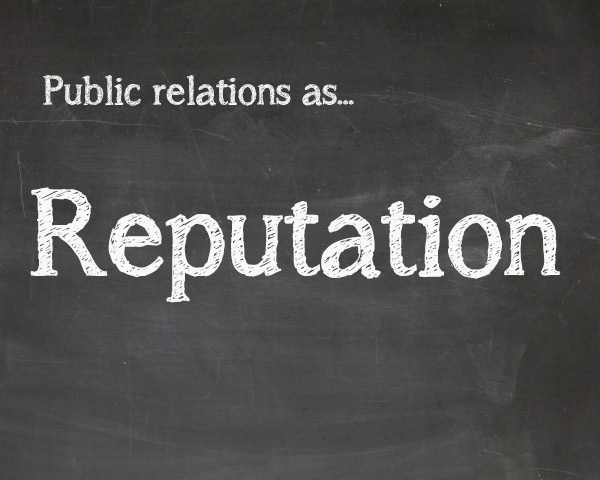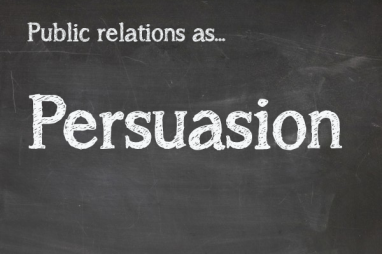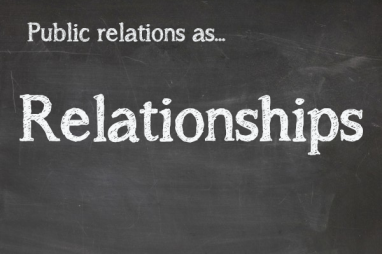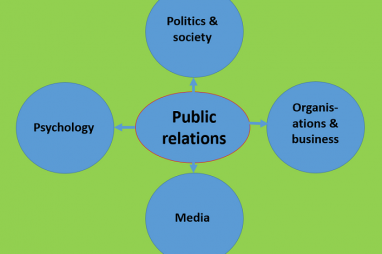Public relations as reputation management

About the author
Richard Bailey Hon FCIPR is editor of PR Academy's PR Place Insights. He teaches and assesses undergraduate, postgraduate and professional students.

In this series of PR Place Insights essays, we hope to enrich students’ understanding of the field and introduce some academic thinking to practitioners. Other essays in the series cover public relations as communication management, public relations as relationship management and public relations as persuasion.
PR Place Insights essay: Reputation
The UK’s Chartered Institute of Public Relations (CIPR) places reputation at the forefront of its definition of the field.
‘Public relations is about reputation – the result of what you do, what you say, and what others say about you.’
So there surely can’t be any dispute about this. Well, for a start, reputation was a later addition to an earlier definition (look carefully and you can see the join). Let’s review it in its entirety:
‘Public Relations is about reputation – the result of what you do, what you say and what others say about you. Public Relations is the discipline which looks after reputation, with the aim of earning understanding and support and influencing opinion and behaviour. It is the planned and sustained effort to establish and maintain goodwill and mutual understanding between an organisation and its publics.’
This argues that public relations is reputation management – but then goes on to suggest that the end result of public-relations-as-reputation-management is not reputation itself but rather ‘goodwill and mutual understanding.’
It’s not apparent from this how a strong reputation contributes to mutual understanding. Surely relationship management and communication management (the subject of further essays in this series) are at least as important in this process?
An appealing concept
Reputation management is an appealing concept for practitioners. It links public relations to the organisation it represents, and suggests a dialogue with senior managers around a topic of pressing importance. It makes public relations advisers, like lawyers, an indispensable professional service.
In doing so, it provides an opportunity for practitioners to take ownership of the whole risk-issues-crisis management cycle and help organisations and senior executives steer the ship through treacherous waters. At times of volatilitity, uncertainty, complexity and ambiguity (VUCA) there’s much work for the public relations adviser.
Given this professional body and practitioner emphasis on public-relations-as-reputation-management, it’s surprising how few public relations scholars focus on reputation research. The field is dominated by those from a business, management or corporate identity background – or by universities with no tradition of teaching public relations, such as Oxford University’s Centre for Corporate Reputation.
For me, the two indispensable practitioner texts are Crisis, Issues and Reputation Management by Andrew Griffin; and Tony Langham’s Reputation Management.
In making a distinctive claim for public relations to take ownership of reputation, Griffin distinguishes between operational crises and reputational crises. Not all operational crises, up to and including loss of life, have a negative impact on reputation, but some inconsequential-sounding words can have a profound impact (as Gerald Ratner discovered).
As Griffin explains it: ‘What identifies a crisis is not the nature of what has happened but what is at stake – reputation, the bottom line, the licence to operate and the future of the organization – and the immediacy of the threat.’
His book shows that reputation is not to be viewed (or managed) in isolation, but as part of a continuous cycle of risks, issues and emergent crises.
It’s an important field – and there will never be a lack of demand for advisers with this expertise. But public relations advisers do not have the only claim on this territory: there are others with greater experience in risk assessment and risk management, as consultant Tim Burt noted in his 2012 book.
It’s a contested area that brings public relations advisers into competition with management consultants and others. (Interestingly, as if to prove this point, Regester Larkin – Andrew Griffin’s employer when he wrote that book – was acquired in 2016 by Deloitte).
In his book, Tony Langham addresses the paradox that while reputation is intangible, it is valuable.
‘I’m not convinced that reputation should appear on the balance sheet… I am convined, however, that reputation should be spoken of as a tangible asset. While it is real and not real at the same time, it exists.’
Three challenges
There are several obvious challenges to the mantra that public relations manages reputation.
The first is that reputation is not under our control. Reputation, like beauty, is in the eye of the beholder. So we can influence how our organisation is perceived, but can we claim full management control of this process? You would be setting yourself up for a fall by promising to manage a process you do not and cannot control.
There are some well-established models explaining the relationship between corporate identity and corporate reputation in the corporate communication and corporate identity literature to help you understand these concepts (see eg Cornelissen, Hatch and Schultz, van Riel).
The second challenge is that if you say you manage reputation, you will very soon be asked how you measure and value reputation (on the grounds that ‘if you can’t measure it, you can’t manage it.’)
Reputation is considered an intangible asset. You can’t touch it (unlike property, or furniture, or stock in a warehouse) but it has a value and some auditors will put a value on it (it used to be known as ‘goodwill’, the word that still appears in the CIPR’s definition cited above).
Intangible assets are in fashion. Economists need to explain how a transport service that owns few cars (Uber) or an accommodation service that owns few bedrooms (Airbnb) can have such high market valuations. A recent economics text made the connection explicit: Capitalism without Capital: The Rise of the Intangible Economy.
So what method will you use to measure reputation?
There is some help provided by scholars. Charles Fombrun (from the US) and Cees van Riel (from the Netherlands) have developed a model known at the Reputation Quotient which measures six drivers contributing to corporate reputation (emotional appeal; products and services; vision and leadership; workplace environment; financial performance; and social responsibility). They are also founders of the Reputation Institute which provides consultancy and tools for reputation measurement.
Private sector businesses with stock market listings already have accurate ways of valuing the business (including goodwill/reputation). The share price is a crude measure, subject to many external factors, but a firm’s market capitalisation (the number of shares in circulation multiplied by the price per share) provides an instant picture of the value the market puts on the business.
Given the volatility in share prices, executives prefer to talk up ‘shareholder value’, which contains an assessment of the confidence shareholders place in the longer-term strategy of the management team. Should they sell their shares at the first sign of trouble, or hold on to them in the belief that over a longer period managers will outperform the market? This involves a form of reputation assessment by shareholders.
The third problem of viewing your role as reputation management is that it can easily lead to unethical practice. If your goal is to protect the reputation of your boss, or organisation or client at all costs, then this leads you to what the media often describes as ‘reputation laundering’ along with greenwashing, sports washing etc (note the use of the laundry metaphor in all these phrases).
Another question to ask is which role in an organisation is responsible for reputation. It’s more likely the answer will be the chief executive than the chief communication officer.
So should public relations practitioners be claiming to manage a discipline they don’t own? In reality, the senior PR manager is more likely to advise on the reputational implications of decisions. There’s a difference between being an adviser and being a decision maker.
All this talk of management, management consultants, auditors and share prices may suggest that reputation management is only relevant to the private sector.
This need not be the case. The UK’s National Health Service (NHS) has a reputation, though it does not have shareholders or customers. Public sector bodies are accountable to us as taxpayers and service users and so has a reputation that’s worth protecting. Yet it’s not a reputation that’s capable of measurement in purely financial terms.
The NHS, with some 1.5 million employees, is a prime example of an organisation that needs to put internal communication first. Reputation clearly has a place in a campaign, say, to reduce hospital-borne infections. But is reputation the driver (above public health)? If so, it would suggest a tendency to close ranks and protect the organisation rather than open up and expose poor practices.
This does happen, but when made public it tends to be catastrophic for the reputation of a hospital or NHS Trust as we saw most recently with the Countess of Chester hospital following the Lucy Letby case.
Reputation has a greater resonance with external communicators than those responsible for internal communication, though many will agree with Quentin Langley that employees should always be considered the first line of defence.
In summary, it’s not as clear as suggested by the CIPR definition that public relations is (uniquely) about reputation.
Even among practitioners, for everyone talking up the importance of reputation, there will be yet more using ‘brand’ as their preferred term.
The ethical defence of reputation management
I had earlier suggested that what you call reputation management might be viewed by someone else as greenwashing, sports washing or reputation laundering.
So how can we defend reputation management as ethical?
Tony Langham argues: ‘In a modern capitalist economy, democracy is strengthened is all elements of society openly communicate. Democracy is weakened by secrecy and opacity. If companies communicate, that is good for society. If they lobby Government, that is how democracy works. But society should be able to see who lobbies who, and how much they spend.’
‘As long as the activity is legal, it seems to me a matter of personal choice who someone works for or represents…. Reputation managers should be transparent about who they are working for, at all times, when the work is in the public domain.’
UPDATE: This article was first published on 7 February 2018 and updated on 8 January 2024.
Further reading
Barnett, M and Pollock, T (eds) (2012) The Oxford Handbook of Corporate Reputation, Oxford University Press
Burt, T (2012) Dark Art: The Changing Face of Public Relations, Elliott and Thompson
Cornelissen, J (2017) Corporate Communication: A Guide to Theory and Practice (fifth edition) Sage
Dietrich, G (2014) Spin Sucks: Communication and Reputation Management in the Digital Age, Que
Doorley, J and Garcia, H (2015) Reputation Management: The Key to Successful Public Relations and Corporate Communication (third edition) Routledge
Fombrun, C and van Riel, C (2004) Fame and Fortune: How Successful Companies Build Winning Reputations, FT Prentice Hall
Frandsen, F and Johansen, W (2017) Corporate image, reputation and identity in Tench and Yeomans, Exploring Public Relations (fourth edition), Pearson
Griffin, A (2014) Crisis, Issues and Reputation Management, CIPR/Kogan Page
Hatch, M and Schultz, M (2008) Taking Brand Initiative: How Companies Can Align Their Strategy, Culture and Identity through Corporate Branding, Jossey Bass
Langham, T (2019) Reputation Management, Emerald Publishing
Langley, Q (2014) Brandjack: How your reputation is at risk from brand pirates and what to do about it, Palgrave Macmillan
Schultz, M, Hatch, M and Larsen, M (eds) (2007) The Expressive Organization: Linking Identity, Reputation and the Corporate Brand, Oxford University Press
Van Riel, C (1995) Principles of Corporate Communication, Prentice Hall
Waddington, S and Earl, S (2012) Brand Anarchy: Managing Corporate Reputation, Bloomsbury
Waddington, S and Earl, S (2013) #BrandVandals: Reputation wreckers and how to build better defences, Bloomsbury


